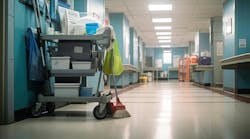Many, if most, schools and universities will soon break for the summer and begin major cleaning and maintenance efforts. This is a terrific opportunity to begin or improve a green cleaning program.
Begin with an audit of current products and practices. Many audits focus solely on cleaning chemicals and miss other opportunities for improvement. Idenify and prioritize opportunities based on importance, cost, risk factors and other desirable criteria.
Cleaning chemicals. Note the complete product name and manufacturer to gather safety data sheets to determine product hazards. In addition, note the location of the product especially if it isn’t in a primary product storage area. “Red flags” include:
- Ready-to-use products
- Dilution equipment, especially if it needs repair
- Aerosol cleaning products
- Chlorine bleach especially outside a laundry area
- Ammonia
- Products labeled “dangerous,” “flammable,” or “poisonous”
- Products that occupants brought from home
- Unlabeled or inappropriately labeled containers
- Any damaged or leaking containers
Paper products. Note the recycled content, size of rolls, and if hand towels are roll or multifold. For roll products, note the size to see if they can be replaced with larger rolls. Additionally, make note of dispensers. “Red flags” include:
- Multifold towel dispensers (large rolls are preferable)
- Dispensers that are broken, damaged or otherwise incorrectly dispensing product, such as when the tension of the dispenser combined with a low-quality (low-strength) paper results in tearing.
Trashcan liners and receptacles. Note liners’ size, recycled content, type and thickness. Multiple sizes of liners typically means a lack of standardization in the size of trash cans, resulting in oversized bags, wasting resources and money. “Red flags” include:
- Trash cans requiring multiple liners
- Trash can liners that are too large/small for the can
- Use of bags made with zero recycled content
Janitorial equipment. Note the manufacturer’s name, model number and size, which then can be matched to equipment spec sheets. Assess the state of repair, paying special attention to damaged switches, cords and other possible hazards. “Red flags” include:
- Visible damage such a bare wires or frayed cords
- Bag vacuum cleaners that do not contain bags
- Vacuum cleaner bags full to capacity (suction declines significantly when bags are a quarter full, and is virtually nonexistent when half full)
- Floor burnishers without vacuum attachments
- Floor scrubbers that leave tracks because of damaged or misaligned squeegees
- Floor scrubbers and carpet extraction equipment with water left in the solution or recovery tank
Entry mats. Most green cleaning programs use entry mats to prevent soils from entering a building. Look for mats at all entries used by students, staff and visitors. Note size, condition and whether the mat is appropriate for the location. “Red flags” include:
- Short mats (mats should be 10 to 12 feet long)
- Curling corners and edges
- Mats that are old, worn or loaded to ineffectiveness
- Mats that move when walked upon
Other products (e.g., mops, buckets, recycling containers, carts). Generally, note the state of repair, size and if the products are suited to the task at hand. Each may offer a “greening” opportunity.


